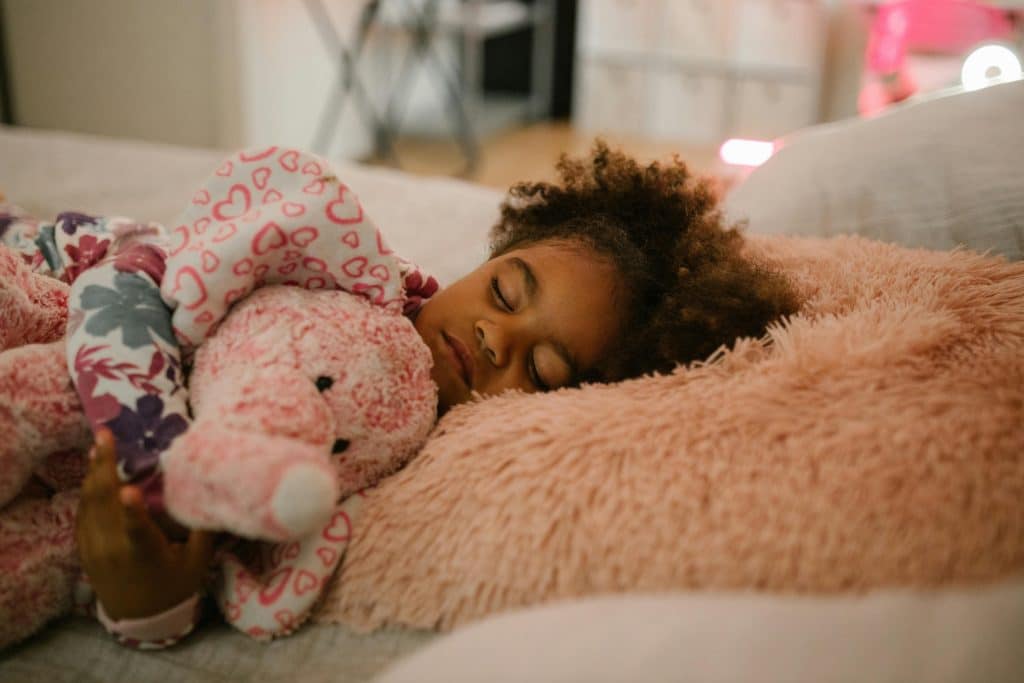As a licensed practitioner who works with kids, I know how crucial sleep is for their growth, development, and overall well-being. Establishing good sleep hygiene habits early on can make a difference in your child’s life. In this blog post, I’ll share some practical tips and strategies to help you create a sleep-friendly environment and routine for your kids, including those with special needs or learning differences.
Table of Contents
The Importance of a Bedtime Routine
One of the most effective ways to promote good sleep hygiene for kids is to establish a consistent bedtime routine. This helps signal their body and mind that it’s time to wind down and prepare for sleep. A typical bedtime routine might include:
- Brushing teeth
- Taking a warm bath
- Reading a calming book together
- Engaging in a quiet, relaxing activity like coloring or puzzles
Consistency is key when it comes to bedtime routines. Try to stick to the same sequence of activities each night, and aim to start the routine at roughly the same time. This predictability can be especially comforting for neurodivergent kids who thrive on structure and familiarity.
Creating a Sleep-Friendly Environment
The bedroom environment plays a significant role in promoting good sleep hygiene for kids. Here are some tips for creating a sleep-friendly space:
- Keep the bedroom quiet, dark, and at a comfortable temperature (around 65°F or 18°C)
- Consider using blackout curtains or a white noise machine to minimize disruptive sounds and light
- Remove electronic devices like TVs, computers, and tablets from the bedroom, as the blue light they emit can interfere with sleep
- Ensure the mattress and pillows are comfortable and supportive
Some children, particularly those with sensory sensitivities, may have specific preferences regarding their sleep environment. For example, they might find a weighted blanket or bedding texture more soothing. Be open to experimenting and finding what works best for your child.

Read more: Does ADHD Affect Sleep?
The Role of Timing and Schedules
Besides a consistent bedtime routine, it’s important to maintain a regular sleep schedule. This means going to bed and waking up simultaneously each day, even on weekends. Letting kids stay up late or sleep in on non-school days can be tempting. Still, significant fluctuations in sleep schedules can disrupt their circadian rhythms and make it harder to fall asleep and wake up when needed.
Research has shown that children with consistent sleep schedules tend to have better quality sleep and fewer behavioral issues. In fact, one study found that preschoolers with irregular bedtimes had more difficulties with attention, behavior, and emotional regulation compared to those with consistent bedtimes (Staples et al., 2015).
Avoiding Non-Sleep Activities in Bed
It’s essential to teach kids that the bed is primarily for sleeping. Avoid letting them spend hours in bed doing other activities like homework, watching videos, or playing games. When we engage in non-sleep activities in bed, our brains begin to associate the bed with wakefulness and stimulation rather than relaxation and sleep.
Instead, encourage your kids to do these activities in other areas of the house, like a designated homework spot or a comfortable reading chair. This helps reinforce the idea that the bed is a place for rest and sleep.
The Impact of Temperature on Sleep
Did you know the bedroom’s temperature can significantly affect sleep quality? Studies have found that the optimal temperature for sleep is around 65°F (18°C). When the room is too warm, it can lead to restless sleep and more frequent awakenings.
| Temperature Range | Effect on Sleep |
|---|---|
| 60-67°F (15-19°C) | Ideal for sleep |
| Above 75°F (24°C) | Can cause restless sleep and awakenings |
| Below 54°F (12°C) | Can make it difficult to fall asleep |
If your child feels too warm at night, use breathable bedding materials like cotton or bamboo and dress them in lightweight pajamas. A fan or air conditioning can also help keep the room comfortable.

Goally | Best Videos to Teach Life Skills
Give your kid an independent future. Goally has 100+ video classes teaching life skills like “How to Choose a Restaurant,” “How to Interrupt Politely,” and “How to Get Ready for School.”
Goally takes kids on an adventure that includes interactive practice and checkpoints along the way! No web browsers, YouTube, or social media.
Establishing good sleep hygiene habits is one of the best gifts you can give your child. By creating a consistent bedtime routine, a sleep-friendly environment, and a regular sleep schedule, you’re setting them up for success in both their waking and sleeping hours. Every child is unique, so be patient and willing to adapt these strategies to your child’s needs and preferences. With a little effort and much love, you can help your kids develop healthy sleep habits that will serve them well.
For more information on sleep hygiene for kids, check out these helpful resources:
- National Sleep Foundation – Children and Sleep – This comprehensive guide covers the importance of sleep for children, recommended sleep durations, and tips for promoting healthy sleep habits.
- American Academy of Pediatrics – Healthy Sleep Habits – Learn about the recommended sleep hours for children of different ages and strategies for establishing a bedtime routine.
- Autism Speaks – Sleep – Find resources and tips specifically tailored for helping children with autism develop good sleep hygiene habits.
FAQ’s About Sleep Hygiene for Kids
Why is sleep hygiene important for kids?
Sleep hygiene is essential for kids because it promotes healthy sleep patterns, leading to better physical, emotional, and cognitive development.
What are some key elements of a good bedtime routine?
A good bedtime routine should include calming activities like taking a warm bath, reading a book, or listening to soothing music, and should be consistently followed each night.
How can I create a sleep-friendly environment for my child?
To create a sleep-friendly environment, ensure the bedroom is quiet, dark, and at a comfortable temperature, and consider using blackout curtains or a white noise machine.
What's the optimal temperature for a child's bedroom during sleep?
The ideal bedroom temperature for sleep is around 65°F (18°C), as cooler temperatures promote better sleep quality.
How can I help my child with special needs establish good sleep hygiene habits?
To help children with special needs establish good sleep hygiene habits, maintain a consistent bedtime routine, create a calming sleep environment, and be open to finding strategies that work best for your child's unique needs and preferences.
Emily is a seasoned blog writer for Goally, leveraging her extensive background in child psychology and special education to provide valuable insights and resources for parents. Her commitment to understanding and addressing the unique needs of these children, combined with her expertise in educational strategies, makes her a credible and empathetic voice for families.






